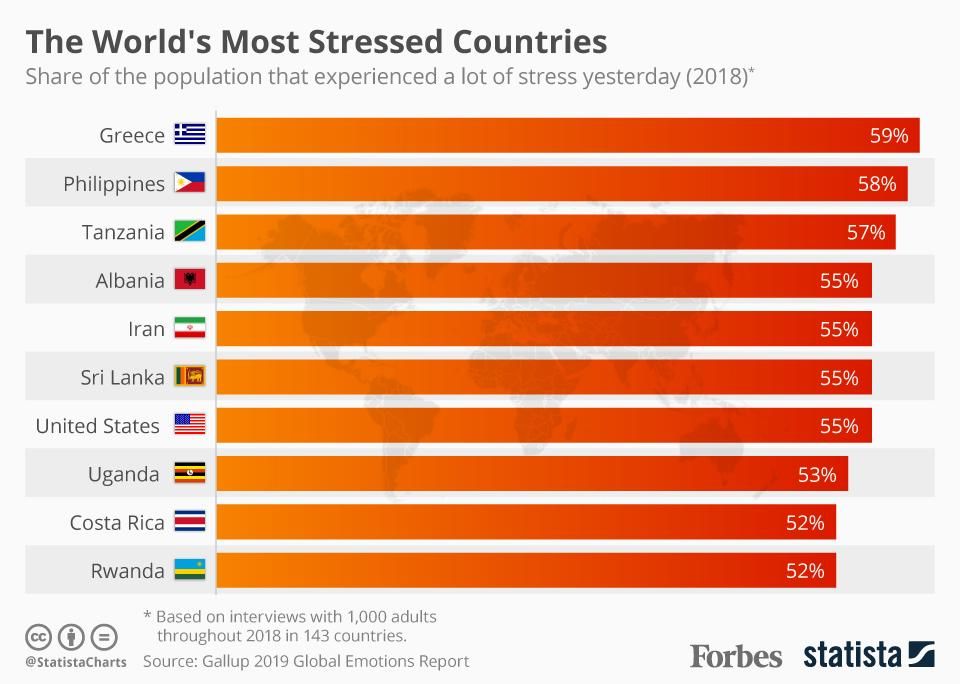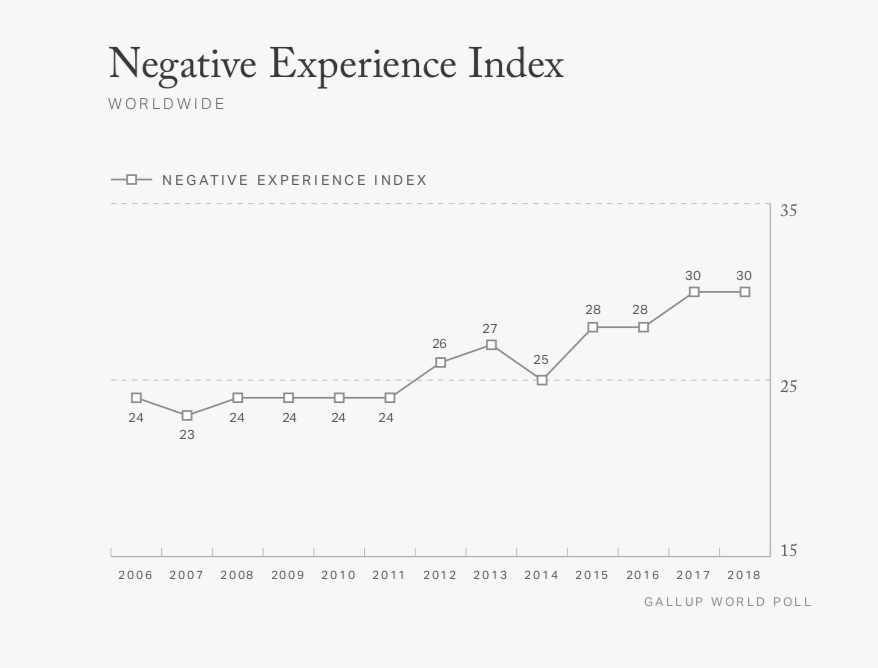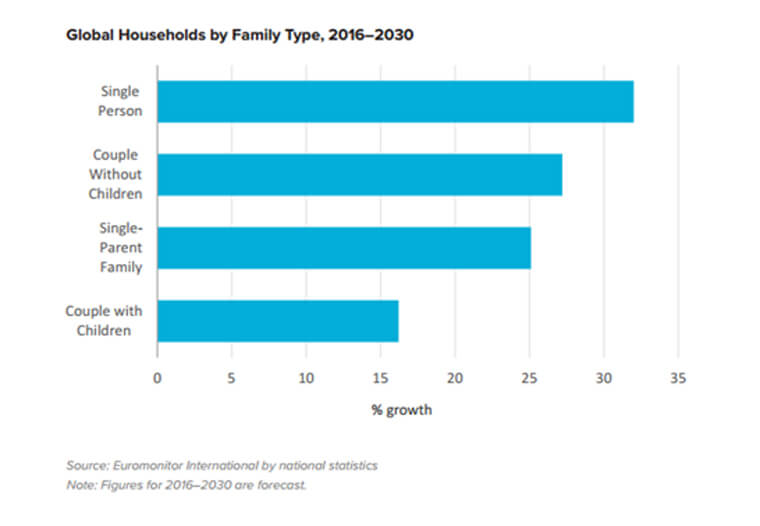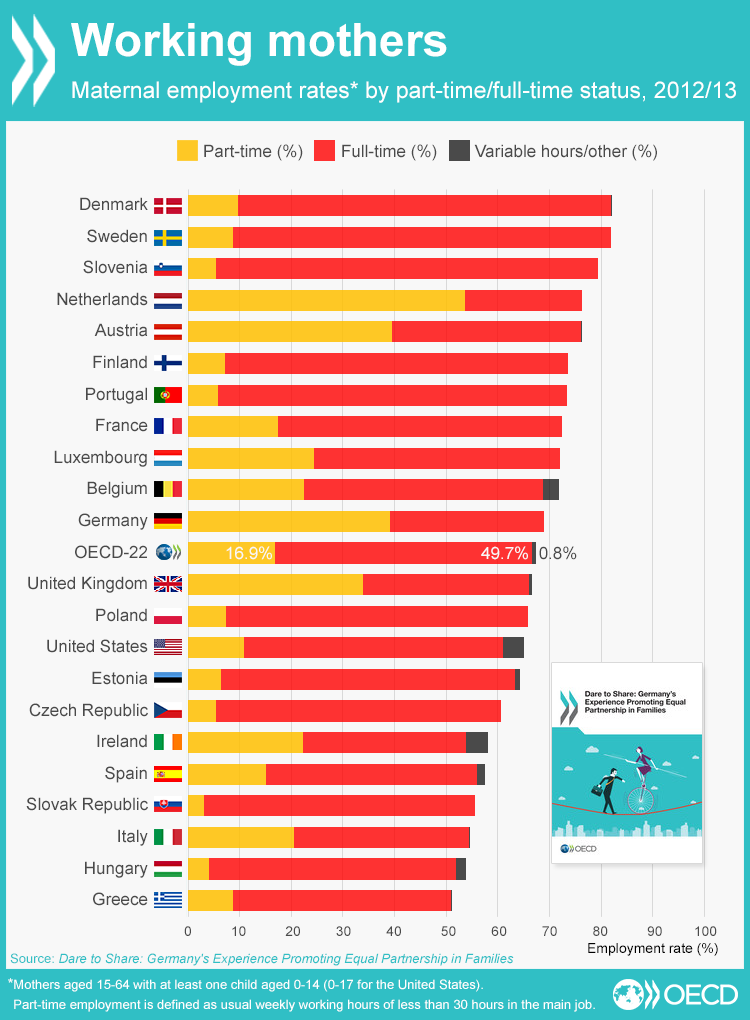July 01, 2019
As the modern family and workplace evolves, employers and governments are challenged to help employees balance the demands of work and family life. The Business Group highlights trends in and selected examples of statutory and employer-sponsored family-friendly and work-life benefits globally, the business case for providing such programs and employer recommendations for implementation.
Why are Family-friendly and Work-life Benefits Becoming More Important?
Stress Levels are High and Getting Higher
Overall, over 1/3 of people report experiencing a lot of stress the day before being surveyed.

Source: Forbes 20191
Gallup’s Negative Experience Index (a measure of worry, stress, sadness, anger or pain on the day before the survey) last year reached its highest point since 2006 and remained there this year.

Source: Gallup, 20192
Modern Families Look Different Than They Used To

Source: Euromonitor International3

Source: OECD4
Employees Are Demanding Work-life Balance
- 14.3% of all surveyed U.K. employees currently unable to work flexibly, and 21% of parents, said they are actively looking for a job that offers flexible working.6
- 54% of respondents to Mercer’s 2019 Global Talent Trends Survey said that managing their work-life balance is one of the top 5 things their employer can do to help them thrive at work (compared to 40% in 2018 and 26% in 2017).7
- 58% of U.K. survey respondents say flex working hours are their most valued benefit. Younger job candidates expect this to be more likely offered in a small- or medium-enterprise.8
- 50% of respondents to Aon’s 2019 Benefits and Trends survey already have 5%-30% of their staff using flexible working arrangements.8
Where, When and How Long We Work Has Changed
For many people, the lines between work and life are blurred:
- More than 400 million of the 1.8 billion employed persons worldwide work more than 49 hours/week.9
- A third of employees globally work remotely always or very often.10
- A 2017 survey showed that Canadian workers spent 11.7 hours spent at work and 5.3 hours at home reading work emails.11
- Almost two-thirds of travelers report checking email on vacation. Only 1/3 completely unplug, even though 77% say they would prefer to do so.12
It Makes Good Business Sense To…
- Provide adequate leave and support new parents. KPMG estimates that hiring and training new employees to replace women who don’t return from maternity leave costs global companies $47 billion/year.13
- Ensure employees have time off for leisure and rest. Long hours are associated with more safety issues. “Working at least 12 hours per day was associated with a 37% increased hazard rate and working at least 60 hours per week was associated with a 23% increased hazard rate.”14
- Keep women in the workforce. . Executive gender and ethnic diversity are correlated with workplace productivity, but women and minorities are underrepresented in management.15
- Provide a variety of work-life benefits and programs. Research shows that employees who believe that they have good work-life balance work 21% harder than those who don’t, even if they don’t take advantage of the employer programs offered.16
How Governments are Responding
Regulating and Formalizing Flex Working
- In the U.K., employees can apply for the right to work flexibly after they have worked for the same employer for 26 weeks. An employer can refuse the request if they have a good business reason to do so.17
- Many Australian employees can request flex work after working for the same employer for 12 months. The employer should meet and try to reach an agreement with the employee, taking the employee’s needs, consequences and business impact into consideration.18
- A recent law in the Philippines ensured that telecommuters would receive fair treatment and the same rights as employees who work physically in the office. This includes measures to “to prevent the telecommuting employee from being isolated from the rest of the working community in the company.”19
Providing or Assisting with Child Care
- India’s Maternity Benefit Act 2017 mandated that employers with 50 or more employees provide crèche facilities close to their workplaces.20
- In 2018, the government of Berlin became the first in Germany to make preschool free for all children.21
Expanding Parental Leave
- In December 2017, the Canadian government (excluding Quebec) began offering eligible parents the choice of 12 of 18 months combined maternity/parental leave after birth of a child. Payment varies based on the amount of time taken, but the employee’s job is protected regardless of length of leave.22
- Irish parents will be able to take an additional 7 weeks each of paid leave to take care of a new child during their first year by 2021. This is in addition to existing entitlements like maternity and paternity leave. The new bill also allows for adoption leave and benefits.23
- Netherlands: as of January 2019, adoption leave for both parents was extended from 4-6 weeks at 100% pay. Paternity/partner leave is one week at 100% pay, to be extended by an additional five weeks in July 2020, payable at 70% pay after employer-paid leave ends.24
- South Africa: in 2018, a law was passed allowing for 10 days of paternity leave and 10 weeks of parental adoption leave is the child is under the age of 2, as well as surrogacy leave. Maternity leave payments increased and were also granted to those losing a child during the third trimester.25
- In 2019, the Hong Kong government increased paternity leave from 3 to 5 days.26
- The Spanish government increased paternity leave to 8 weeks through 2019, 12 weeks through 2020 and 16 weeks starting in 2021.27
- In the first half of 2018, 17% of South Koreans who took parental leave were men: an increase of 66% from the same period last year. The rise is attributed to expanded financial incentives from the government that were especially impactful for smaller companies.28
- Starting in 2020, employees in the U.K. who lose a child under the age of 18 or after 24 weeks of pregnancy will receive 2 weeks leave.29
Assisting New Parents with Health and Well-Being
- Netherlands: a maternity nurse visits new mothers 8 hours each day for 8 days to help with errands and chores and to conduct health checks.
- Japan: women stay in the hospital for up to 10 days to recover from childbirth.
- France: women receive physiotherapy after childbirth to prevent and/or treat bladder incontinence caused by weakened pelvic floor muscles.
- Sweden: after new mothers are discharged from the hospital, they are cared for by community nurses in early days.
EU Work-Life Balance Directive
Approved in 2019 with goal of increasing women’s representation in workforce and encouraging gender equality around caring responsibilities. The directive provides for:
Paternity and caregiving leave:
- Fathers (or equivalent second parents) in Europe will receive 10 days paid paternity leave
- Those having a relative in need of care will receive 5 days
The right to request flexible working arrangements:
- Does not define what this means
- Provides examples such as reduction in hours, change in time/place of work, change in working patterns, etc.
Higher standards of leave:
- Increases the length of the period of parental leave that cannot be transferred between parents from 1 to 2 months
- Obligates payment for parental leave (but doesn’t specify amount)
Employer Examples
Expanding or Broadening Parental Leave
- In early 2019, Novartis announced that all company employees worldwide would receive at least 14 weeks parental leave, regardless of gender.30
- On July 1, 2019, Diageo rolled out a minimum 26-week of paid maternity leave and 4 weeks of paternity leave for all its employees around the world. In certain markets, fathers will also receive 26 weeks paternity leave.31
- By the end of 2020, DuPont will offer a minimum of 4 weeks of paid leave to all new parents, including adoptive and same-sex parents. This is in addition to 12 weeks maternity leave for birth mothers.32
- Zomato recently began offering a minimum of 26 weeks parental leave to all new parents, regardless of gender. The policy includes same-sex and adoptive parents.33
- As of 2017, Ikea gives mothers and fathers 26 weeks of parental leave in India. The policy applies to parents who have children through birth, adoption and surrogacy, and mothers can work half days for 16 weeks upon their return to work.34
- In 2015, Vodafone began offering a minimum global maternity policy across 30 countries. Women at all levels are offered at least 16 weeks fully paid leave, as well as full pay for a reduced week for the first six months after they return.13
- In 2019, Volvo Cars announced a gender-neutral parental leave policy for employees in EMEA. Both mothers and fathers will receive 80% pay for 6 months. The initiative is a pilot that may eventually be rolled out worldwide.35
- Guinness Nigeria recently announced a new policy that offers female employees 26 weeks fully paid parental leave and male employees 4 weeks paternity leave at full pay.36
- Starting in 2017, Korea’s Lotte Group began mandating one-month paternity leave at 100% pay, since so few men in the country take it. They extended maternity leave from one to two years for women as well.37
- In April 2019, telecommunications firm O2 began offering 14 weeks paid paternity leave to all permanent employees, including heterosexual and same-sex couples, as well as adoptive and surrogate partners.
- The Financial Services Compensation Scheme in the U.K. extended its maternity and paternity leave policies to support parents whose children were born prematurely. Employees can lengthen their leave entitlement by the number of days their baby is born prior to the due date.
Implementing Flex Work Opportunities and Holistic Well-Being Programs
- New Zealand company Perpetual Guardian implemented a 4-day work week in 2018. Results showed decreased employee stress levels and increased job performance, enjoyment and life satisfaction. Find more here about the trial and permanent policy.
- Japanese company Crazy, Inc. awards employees who sleep 6 or more hours per night with points that can be used for food in the company cafeteria. Crazy also promotes better nutrition, exercise and a more positive work environment.
- In May 2019, PricewaterhouseCoopers (PWC) announced that they will pay full superannuation contributions for up to 12 months for employees in Australia on parental leave. The goal is to demonstrate commitment to gender equality, since women often face an earnings gap in relation to men.
Other Approaches to Promoting Work-Life Balance
- Target recently announced a suite of upgraded family-friendly benefits for hourly and salaried workers, including backup care, increased financial assistance for surrogacy and adoption and family care leave for any immediate family member.
- CBRE banned employees from eating lunch at their desks in order to encourage them to take a break, connect with colleagues and have healthier workstations. Employees are also required to leave at the end of the day with a clean desk.
- State Street has formalized : flex place (remote working), flex time, compressed schedules, reduced schedules or job-sharing. Child, elder and personal care referrals and resources, and emergency back-up daycare are also available
- Indian software company Zoho provides space for children and (parent-provided) nannies to spend the entire day on-site. Nannies receive free lunch and employees can visit their children during break times.
Recommendations for Global Companies
Understand Local Regulations
While tempting, it might not be possible to roll out the same policies in every location. Employers should work with their local staff and legal counsel to understand the following before moving forward:40
- How much discretion is allowed: Using phrases like “up to” may go against the “requirement that voluntary benefits not be subject to an employer’s discretion and have clear and objective criteria for eligibility.” It may also insinuate that different classes of employees may receive different amounts of leaves, which may also not be allowed and could be grounds for a discrimination claim.
- How the policy will interact with social security and/or government insurance–paid leave: Ideally policies should answer questions about whether the “company will pay an employee during any social security or government insurance–paid leave, resulting in a double benefit, and whether the company will pay the employee during the remainder of the leave after the government-provided leave expires.”
- Prenatal leave requirements: In some countries, employees are mandated to take a portion of their leave before the baby is born. Employers will want to clarify how that will align with any parental leave given by the company.
- How leave pay will be calculated: Some countries require that salary during leave be calculated in specific ways. “Employers may want to consider either removing language reflecting that pay during leave is based only on salary or including a caveat that the policy is subject to applicable law.”
- Language Requirements: In some countries, policies must be communicated in local language
Solicit Feedback
- Have a strong process in place for feedback so that all employees can share what is working and what isn’t
- Survey employees about their work-life balance and what programs and benefits they would most need to help improve that. Needs may differ by geography
- Consider pilot programs in certain locations/businesses before rolling out to the entire company
- Get input from local HR staff about what they’re hearing from employees and seeing in the office. Are people staying until managers leave so they get face time in the office? Is there a culture where people don’t feel they can ask for time off to use flex programs? If so, how can that be changed and how can managers be held accountable for changing it?
- Look at utilization rates related to various programs. Is there a gender divide? If so, why and how can that be addressed?
- Consider data collection related to metrics like productivity, engagement and business outcomes that continue to make the case for work-life programs and family-friendly benefits
Talk the Talk and Walk the Walk
- Use testimonials and success stories to show employees and managers that using work-life programs works and is ok
- Reassure employees, particularly men, that taking advantage of family-friendly benefits will not impact their career (and hold managers accountable for that)
- Use champions and leaders to spread the word about available programs and benefits, including their own use of them
- Provide financial incentives when possible that allow people to fully take parental leave and/or use other benefits as needed
- Ensure that employees who are taking advantage of flex work and remote working programs have access to the same opportunities that employees who are working physically in the office have
- Don’t make assumptions about caregiving responsibilities or need for programs/benefits based on a person’s gender, age or life circumstances
- Consider creative options like mandatory minimum vacation time or asking employees to take lunch breaks away from their desks
Train Managers and Employees on Flex Work
- Make the business case for work-life and family-friendly benefits/programs to managers.
- Ensure that you have the technology needed for remote workers to be successful and to feel part of the team in the office.
- Make expectations and guidelines for remote working clear to all employees.
- Train managers on how to successfully supervise employees who are working remotely or using flex hours.
- Change the culture: performance is based on outcomes, not hours worked.
- Consider how shift workers may be able to utilize flex work options too. Work with managers on relief pools, shift-sharing, asking for employee input into schedules, rotating weekend hours and providing schedules far in advance.
- Help managers identify signs of misuse and abuse of family-friendly and work-life benefits so that they are used appropriately and aren’t at risk due to inappropriate use.
More Topics
Articles & Guides- 1 | Forbes. Report: U.S. Among The Ten Most Stressed Nations Worldwide [Infographic]. https://www.forbes.com/sites/niallmccarthy/2019/04/26/report-u-s-among-the-ten-most-stressed-nations-worldwide-infographic/#4b86d1ba6a0c. Accessed November 1, 2019.
- 2 | Gallup. Gallup 2019 Global Emotions Report. https://www.gallup.com/analytics/248906/gallup-global-emotions-report-2019.aspx. Accessed November 1, 2019.
- 3 | Euromonitor International. Households in 2030: Rise of the Singletons. https://blog.euromonitor.com/households-2030-singletons/. Accessed November 2, 2019.
- 4 | Dare to Share: Germany's Experience Promoting Equal Partnership in Families. Paris: OECD;2017.
- 5 | O'Brien M. Work-Family Balance Policies University of East Anglia;2016.
- 6 | Dealer Support. UK employees moving to flexible workplaces to improve mental health. https://dealersupport.co.uk/uk-employees-moving-to-flexible-workplaces-to-improve-mental-health/. Accessed November 1, 2019.
- 7 | Global Talent Trends 2019. Mercer;2019.
- 8 | Aon. 58% cite flexible working as most valued benefit. https://employeebenefits.co.uk/issues/september-online-2017/58-cite-flexible-working-most-valued-benefit/. Accessed November 1, 2019.
- 9 | BBC. What happens when we work non-stop. https://www.bbc.com/worklife/article/20180823-how-bad-for-you-is-working-non-stop. Accessed November 1, 2019.
- 10 | Workplace Trends. The Work Connectivity Study. https://workplacetrends.com/the-work-connectivity-study/. Accessed November 1, 2019.
- 11 | Global News. This is how much time you spend on work emails every day, according to a Canadian survey. https://globalnews.ca/news/3395457/this-is-how-much-time-you-spend-on-work-emails-every-day-according-to-a-canadian-survey/. Accessed November 1, 2019.
- 12 | The Washington Post. Still checking your work email on vacation? You’re not alone. https://www.washingtonpost.com/lifestyle/travel/still-checking-your-work-email-on-vacation-youre-not-alone/2017/08/03/9e313cb4-68a7-11e7-a1d7-9a32c91c6f40_story.html?noredirect=on. Accessed November 1, 2019.
- 13 | BBC. Vodafone offers global maternity equality. https://www.bbc.com/news/business-31761572. Accessed November 1, 2019.
- 14 | Dembe AE, Erickson JB, Delbos RG, Banks SM. The impact of overtime and long work hours on occupational injuries and illnesses: new evidence from the United States Occupational and Environmental Medicine.62(9):588-597.
- 15 | Forbes. More Evidence That Company Diversity Leads To Better Profits. https://www.forbes.com/sites/karstenstrauss/2018/01/25/more-evidence-that-company-diversity-leads-to-better-profits/#790c49731bc7. Accessed November 1, 2019.
- 16 | Inc. How Work Life Balance Can Keep Your Employees Happy and Your Business Healthy. https://www.inc.com/john-rampton/how-work-life-balance-can-keep-your-employees-happy-and-your-business-healthy.html. Accessed November 1, 2019.
- 17 | Government of the United Kingdom. Flexible working. https://www.gov.uk/flexible-working. Accessed November 1, 2019.
- 18 | Australian Government. Flexible working arrangements. https://www.fairwork.gov.au/employee-entitlements/flexibility-in-the-workplace/flexible-working-arrangements. Accessed November 1, 2019.
- 19 | eLegal. An Overview of the new Telecommuting Act (Work from Home Law). https://elegal.ph/an-overview-of-the-new-telecommuting-act-work-from-home-law/. Accessed November 1, 2019.
- 20 | Mercer. India Issues Workplace Crèche Guidelines. https://www.mercer.com/our-thinking/law-and-policy-group/india-issues-workplace-creche-guidelines.html. Accessed November 1, 2019.
- 21 | The Guardian. Berlin abolishes kindergarten fees in German first. https://www.theguardian.com/world/2018/aug/01/greens-among-critics-as-pre-school-berliners-get-free-childcare. Accessed November 1, 2019.
- 22 | Global News. New parental leave benefits: Here’s what you need to know. https://globalnews.ca/news/3852880/new-parental-leave-benefits-heres-what-you-need-to-know/. Accessed November 1, 2019.
- 23 | RTE. New paid parental leave and benefit from November. https://www.rte.ie/news/ireland/2019/0423/1045049-parental-leave/. Accessed November 1, 2019.
- 24 | Willis Towers Watson. Netherlands: Extended adoption and paternity/partner leaves being phased in from 2019. https://www.willistowerswatson.com/en-US/Insights/2019/04/netherlands-extended-adoption-and-paternity-partner-leaves. Accessed November 1, 2019.
- 25 | News 24. Working dads can now take paternity leave for 10 days. https://www.news24.com/SouthAfrica/News/working-dads-can-now-take-paternity-leave-for-10-days-20181127. Accessed November 1, 2019.
- 26 | The Government of the Hong Kong Special Administrative Region. Five-day statutory paternity leave to take effect on January 18. https://www.info.gov.hk/gia/general/201901/11/P2019011100352.htm. Accessed November 1, 2019.
- 27 | Mondaq. Spain: Extension To Paternity Leave. 28 | Quartz. Almost no men used to take South Korea’s generous paternity leave. That’s changing. https://qz.com/1335909/number-of-south-korean-men-taking-paternity-leave-jumps-66-in-2018/. Accessed November 1, 2019.
- 29 | Littler. UK Parental Bereavement Leave – New Rights to Leave and Pay. https://www.littler.com/publication-press/publication/uk-parental-bereavement-leave-new-rights-leave-and-pay. Accessed November 1, 2019.
- 30 | Novartis. Global Equal Parental Leave Policy for all Novartis parents. https://www.novartis.com/news/global-equal-parental-leave-policy-all-novartis-parents. Accessed November 1, 2019.
- 31 | Human Resources Online. Diageo rolls out 26 weeks of maternity leave, 4 weeks of paternity leave globally. https://www.humanresourcesonline.net/diageo-rolls-out-26-weeks-of-maternity-leave-4-weeks-of-paternity-leave-globally/. Accessed November 1, 2019.
- 32 | DuPont. DuPont Enhances Global Parental Leave Policy. https://www.dupont.com/news/dupont-enhances-global-parental-leave-policy.html. Accessed November 1, 2019.
- 33 | Business Today. Zomato introduces 26-week paid parental leave for both men and women. https://www.businesstoday.in/current/corporate/zomato-parental-leave-policy-paid-26-week-both-men-women/story/353791.html. Accessed November 1, 2019.
- 34 | CNN Business. Ikea gives India employees six months paid parental leave. https://money.cnn.com/2017/03/15/news/india/ikea-india-parental-maternity-leave/index.html. Web site. Accessed November 1, 2019.
- 35 | Employee Benefits. Volvo Cars introduces gender-equal parental leave policy for EMEA employees. https://employeebenefits.co.uk/volvo-gender-equal-parental-emea/. Accessed November 1, 2019.
- 36 | Guiness Nigeria. Guinness Nigeria announces fully paid 26-week parental leave for female employees. https://www.guinness-nigeria.com/news-and-media/features/guinness-nigeria-announces-fully-paid-26-week-parental-leave-for-female-employees/. Accessed November 1, 2019.
- 37 | The Korea Times. Lotte Group to mandate paternity leave. http://www.koreatimes.co.kr/www/news/biz/2016/12/123_220165.html. Accessed November 1, 2019.
- 38 | O2 The Blue. O2 extends paid paternity leave to 14 weeks. https://news.o2.co.uk/press-release/o2-extends-paid-paternity-leave-to-14-weeks/. Accessed November 1, 2019.
- 39 | Employee Benefits. FSCS extends maternity and paternity leave for parents of premature babies. https://employeebenefits.co.uk/fscs-maternity-paternity-premature/. Accessed November 1, 2019.
- 40 | Atlanta Business Chronicle. 5 common issues multinational employers may encounter when implementing leave policies. https://www.bizjournals.com/atlanta/news/2019/02/15/5-common-issues-multinational-employers-may.html. Accessed November 1, 2019.
This content is for members only. Already a member?
Login
![]()
